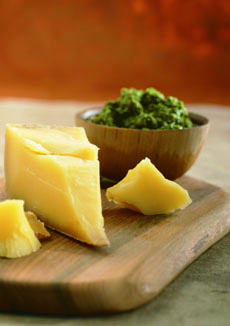TIP OF THE DAY: 20+ Uses For Pesto
|
The Italian word pesto means paste; the verb pestare means to pound or bruise. Classic pesto sauce, which originated in the basil-rich Italian province of Liguria, consists of basil, garlic, olive oil, pine nuts, Parmesan and Pecorino cheeses plus a touch of salt for seasoning. It is traditionally made by pounding the ingredients with a mortar and pestle, which releases more of the flavorful oils in the basil than those made by the blades of a food processor or in commercial production. But, switch out the basil for other greens (arugula, spinach), ditch the greens entirely (kalamata olives; orange, red or yellow bell pepper; sundried tomato), switch the nuts (pistachio, walnut), change the seasonings (try sundried tomato pesto with chipotle). You can even add fresh tomato, ricotta, yogurt or crème fraîche. Pink pesto, an American invention, is a mix of fresh tomatoes, a bit of pesto, some onions and a hint of cream. Garlic lovers should try roasted garlic pesto, a rich, golden paste flecked with herbs and small walnut chunks. |
Pesto as a cheese condiment. Photo courtesy EatWisconsinCheese.com. |
|
|
Don’t be hesitant: Try anything. The pestobilities are endless! Pesto At Breakfast |
||
|
|
Pesto At Lunch & Dinner |
|
|
In Liguria, popular pesto-and-pasta dishes include trenette and triofe alla Genovese. Trenette, flat ribbon pasta almost identical to linguine with a surface the sauce can cling to. Triofe are dumpling-like, rolled, worm-shaped pasta with crevices for pesto to fill. You can substitute gnocchi; and if you’re a penne or rigatoni person, go for it. You can use any substantial pasta that can take a heavy dressing (i.e., not angel hair); and by all means, use pesto instead of red sauce in your lasagne. Here’s how to match pasta shape to type of sauce. Whether it’s your own or store-bought, here’s how to store pesto. Our favorite pesto brands. |
||

